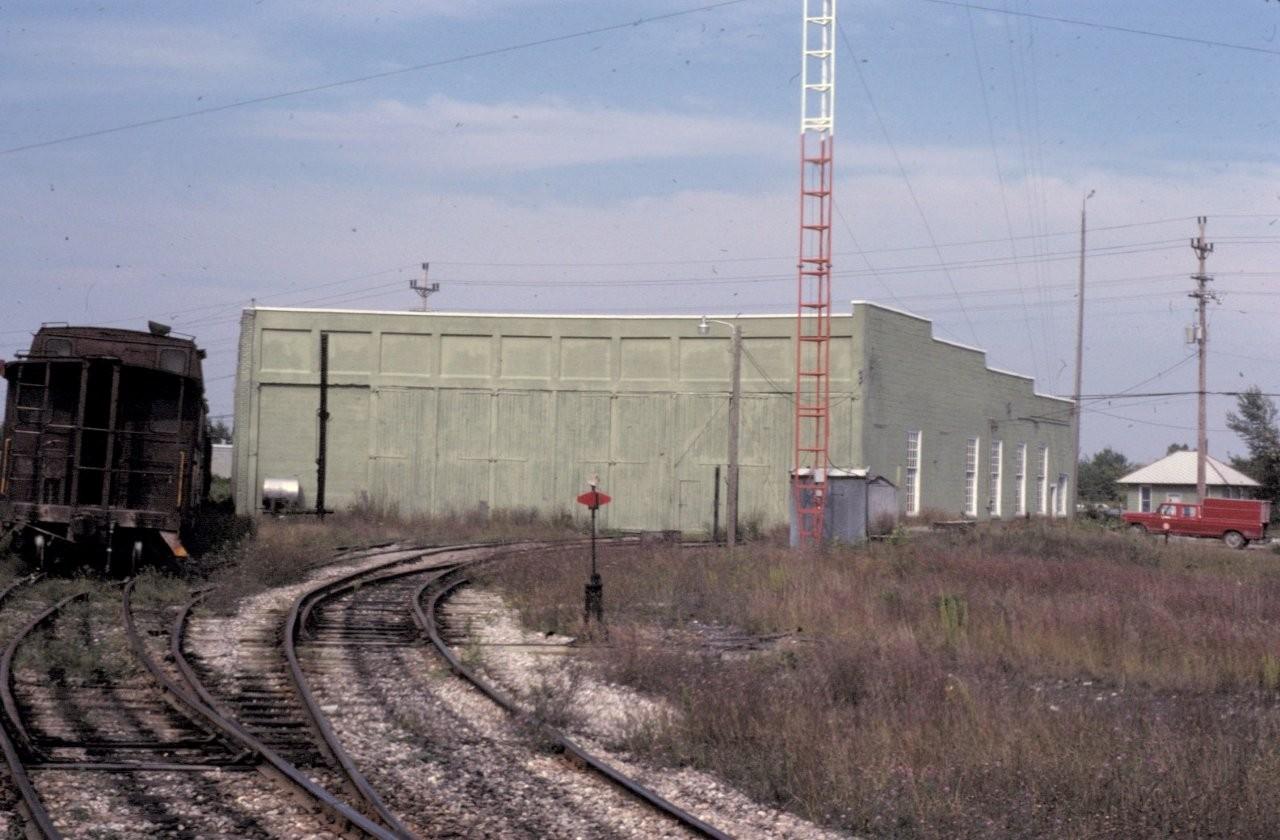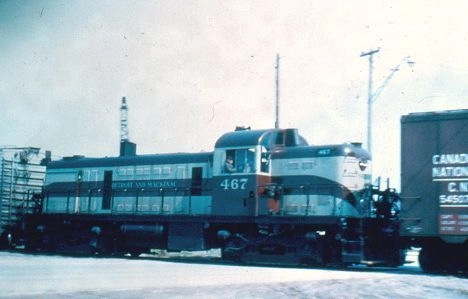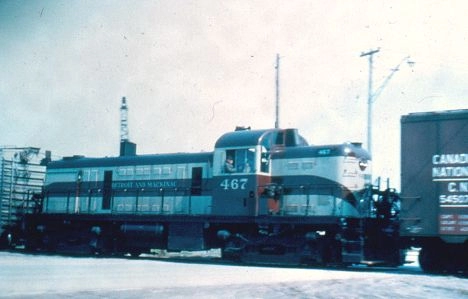- Details
- Hits: 2735
Location: Alpena, MI - D&M and predecessor facilities

The Detroit & Mackinac railway had a five-bay roundhouse within the wye at Alpena Junction, on the north side of downtown. In later years, this roundhouse was accessed by switches rather than a turntable. The roundhouse continues to exist today (2023) and is used by the Lake States Railway.
Photo Info: Top, the D&M roundhouse at Alpena Junction in 1981. [Charles Geletzke Jr.]. 2nd photo, D&M 467 switches at Alpena Jct. in 1960. This was the D&M's original paint scheme for diesel road units. [Harold Frye]
 Notes
Notes
In Alpena, the Detroit & Mackinac was created by the assembly of two seperate railroads - the Detroit, Bay City & Alpena (from the south side of the Thunder Bay river going south) and the Alpena & Northern railway (from the north side of the Thunder Bay river going to the northwest.
The DBC&A had a river line which extended east along the south side of the river towards downtown Alpena to service lumber mills. The A&N had a similar line which extended east along the north side of the river to what today is known as "old town" Alpena. The DBC&A and the A&N connected when a bridge over the river was put in place.
Each railroad had passenger facilities in Alpena. Once the bridge was put in place (by 1895) when the roads merged into the Detroit & Mackinac railroad, the D&M appears to have used the former A&N depot and freight house which were located at West Fletcher and Merchant streets on the north side of the river. The depot is gone today, but the freight house continues to exist as a restaurant.
A new Alpena depot was built in 1910 by the D&M along their main line at Tawas Street. This depot was large by the standards of a town the size of Alpena, and was of brick construction. It was used by the D&M until passenger service was discontinued about 1950. The depot was sold and used for various business purposes and later burned down in the 1990's.
The D&M served many industries mostly along both sides of the Thunder Bay river, including logging, saw, planing shingle and stave mills, tanneries, manufacturing, aggregates and cement. Though freight came from various sidings and spurs, the original D&M freight yards appear to have been along the former A&N main line, north of the Thunder Bay river (between Johnson Street and Alpena Junction). According to old maps, the D&M had about five yard tracks along this line and two tracks here are still used today. They also had spurs and sidings here to various industries along the north side of the river including the Alpena Automobile plant, saw mills and the Besser plant.
The wye tracks at Alpena Junction appear to be in place by 1900 and may go back to the construction of the A&N in 1893. Newspaper articles suggest that the roundhouse was built around 1900 as well. But it appears that the yard east of Alpena Junction was not filled out for several years.
Note: From 1912 until 1932, the BCB&A's main line crossed the D&M northern division main line and curved through the quarry branch in what would be the middle of this yard. The yard, which is now six tracks, would have had crossing diamonds on all of these tracks, making this unlikely the D&M yard was built until the late 1920's when the BCG&A began to decline.
This yard became the main marshalling yard for D&M trains and is still used by the Lake State railway.
The D&M had at least two other roundhouses, one in Tawas and the other at North Bay City.
Time Line
1900. The D&M is clearing ground for a new roundhouse at Alpena Junction in a novel manner. The stumps are thick on the spot, but instead of bothering with dynamite a chain is would round the stump to be removed, the other end attached to a locomotive on the track near by, and in about 30 seconds after the engine starts up the stump, roots and all, is lying on the top of the ground ready to be carted away. [SJH-1900-0616]
1910. The new D&M depot at Tawas Street is built.
1912. The railroad commission approves the crossing of the D&M & BCG&A east of Alpena Junction. [MCR-1912]
1914. More than 100,000 tons of coal is in danger of going into the Thunder Bay river as a result of the sagging of the D&M railway dock on which is piled the coal shipped into Alpena by water for winter use. The dock is giving away rapidly and already about 100 tons of coal have gone into the river Clam shell derricks are working night and day to move the coal further back from the river but the loss will be considerable. The channel into which the coal slipped was dredged out this season. [DFP-1914-1129]
Bibliography
The following sources are utilized in this website. [SOURCE-YEAR-MMDD-PG]:
- [AAB| = All Aboard!, by Willis Dunbar, Eerdmans Publishing, Grand Rapids ©1969.
- [AAN] = Alpena Argus newspaper.
- [AARQJ] = American Association of Railroads Quiz Jr. pamphlet. © 1956
- [AATHA] = Ann Arbor Railroad Technical and Historical Association newsletter "The Double A"
- [AB] = Information provided at Michigan History Conference from Andrew Bailey, Port Huron, MI

